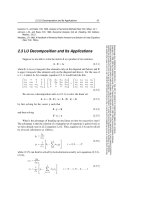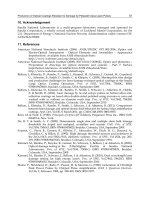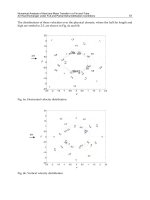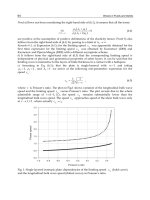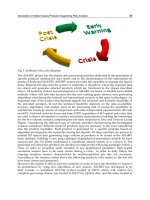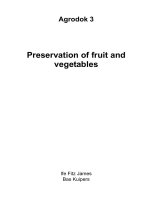Preservation of fish and meat - Part 4 docx
Bạn đang xem bản rút gọn của tài liệu. Xem và tải ngay bản đầy đủ của tài liệu tại đây (234.3 KB, 12 trang )
Salting
25
4 Salting
4.1 General information
By salting food, storage life is prolonged. Salt absorbs much of the
water in the food and makes it difficult for micro-organisms to sur-
vive. For salting, it is important that the fish or meat has been pre-
pared in such a way that the salt added can quickly draw into the flesh
and the moisture can leave the fish or meat. Large pieces of flesh must
be cut into thin slices to allow this.
Fish are divided in half or even in quarters depending on their size.
Fish smaller than 10 cm (anchovies, sardines) usually only have their
intestines removed. Fish of ± 15 cm are split open so that the surface
area of the fish is increased, salt can penetrate better, and the flesh of
the fish therefore becomes thinner. Large cuts can be made in fish 25
cm or longer, or these can be split a number of times (see Chapter 3).
To learn how to salt fish, for example the amount of salt needed and
the effect of those quantities on the firmness and the taste of the fish, it
is recommended at first to use small amounts of different kinds of fish
that are easily available. It is easier to start with non-fatty kinds of
fish. Lean fish is recognizable by its white or very pale flesh. More
fatty fish usually have a darker colour.
The quality of the starting material to be used must be good. Old, rot-
ten fish or fish of poor quality is not improved by salting it and is cer-
tainly not storable for longer. The same is true for meat.
Salt intended for salting fish should be as clean as possible. The salt
may not contain any dust, sand, etc. Salt can contain bacteria which
can survive despite a very high salt concentration. These bacteria can
therefore also cause salted fish or meat to spoil. Strongly contaminated
salt can be recognized by a slightly pink colour. It can be heated on a
Preservation of fish and meat
26
metal plate over a fire to kill the bacteria. Salt can be very fine or have
large chunks; a mixture of fine and coarse salt is best.
During the salting of fish and meat in the tropics, attention must be
paid to the following:
1 Use the cleanest salt available.
2 Use enough salt. Note that salting products is not the same as using
a lot of salt. Large amounts of salt give fish and meat a very salty
taste. At the same time many of the nutrients are lost if too much
salt is used.
3 The water which is to be used must not be contaminated; it must be
clean and clear (drinking water quality).
4 The most effective way of preserving fish and meat is to combine
salting with smoking or drying.
4.2 Salting fish
Three ways of salting fish are described here: dry and wet salting (in
technical jargon: kench salting and pickle curing) and brining. The
first two methods result in fish with a relatively high salt content, the
third method is usually used if one wants fish with a relatively low salt
content.
For kench salting and pickle curing, 30-40 kg of salt is used per 100
kg of cleaned fish. Using more salt does not improve the process and
only leads to unnecessarily high costs: salt is expensive.
Dry salting fish: kench salting
Coarse salt is more suitable for dry (kench) salting. Fine salt will draw
water too quickly from the outside of the fish, making the outside
hard. As a result the water inside the fish cannot escape and the salt
cannot penetrate deep into the fish. Therefore the fish spoils despite
being salted. This is known as ‘salt burn’. Coarse salt does not have
this effect. Kench salting is very suitable for mainly lean kinds of fish.
Salting
27
You will need:
? Split fish or fish fillets (see Chapter 3). If the flesh is thick, make
cuts in it so the salt can penetrate well.
? Salt. Use 30-35 kg of salt for 100 kg of cleaned fish. Use more salt
where deep cuts have been made or where the flesh is thicker.
? Baskets or other perforated containers from which moisture can
drain.
Figure 6: Kench salting
Preservation of fish and meat
28
Method of working (see Figure 6):
1 Split fish or fish fillets.
2 Rub the fish well with salt, especially in the deep cuts.
3 Put a thick layer of salt in the bottom of the basket or container.
4 Place one layer of fish with the skin facing up on the salt. The fish
are not allowed to overlap.
5 Follow with one layer of salt, one layer of fish, etc. until the basket
is full.
6 Cover the basket with a layer of plastic but do not put any weights
on it.
By adding salt to fish, moisture is drawn out of the fish. This moisture,
with the salt dissolved in it, is called brine. Place the basket on some
stones so the brine can drain.
Take care with this method that the fish is piled in such a way that the
brine can drain easily and will not collect in spots. If it does, it causes
an uneven preservation. After a day the fish must be stacked anew so
that the fish which was originally on the bottom now lies on top of the
pile. The salt is thus distributed more evenly (replenish it if necessary)
and you will not get the effect that the fish on the bottom of the pile
has a different amount of salt than the fish on top.
After being salted, the fish must look clear and see-through. The fish
must feel firm and have a whitish salt layer all over it. A fishy smell
and the smell of brine must dominate.
Strongly salted fish, if it is properly covered, can be stored for a long
time. A disadvantage of this method is that the brine drains away, leav-
ing the fish standing dry. Fatty kinds of fish can then turn rancid as
they are exposed to air. Scavengers can easily get to the fish and bac-
teria and moulds cause decay there where insufficient salt has been
used.
Salting
29
Wet salting fish: pickle curing
Wet salting is a good way to preserve fatty fish such as herring, sar-
dines, anchovies and mackerel. With this method the fish is better pro-
tected against vermin and a more uniform salt distribution is achieved.
You will need:
? A clean watertight barrel with a lid of a smaller diameter than the
barrel itself. It must not be made of iron, zinc or aluminium because
of corrosion. Plastic, wood, clay or stainless steel is acceptable.
? Large stones washed clean to be used as weights.
? Salt. Use one kg of salt for three kg of fish, which is equal to 30-35
kg of salt for 100 kg of fish.
? A bucket or large pan in which to make brine.
? Fish. With small fish (<10 cm): leave the fish whole.
? With large fish (>10 cm): remove the intestines (see Chapter 3).
Method of working:
1 Put a thick layer of salt on the bottom of the barrel.
2 Put one layer of fish on the salt with the skin facing up.
3 Cover the fish with a layer of salt and make sure that no parts are
left uncovered. Use more salt at deep cuts or thicker flesh.
4 Alternate one layer of salt, one layer of fish, etc. Make sure the fish
do not overlap. Finish with a layer of fish with the skin facing up.
5 Cover the final layer of fish with a thick layer of salt.
6 Cover the barrel with the lid and distribute the weights evenly on
top of it.
As explained above, by adding salt to fish, moisture is drawn out of
the fish. This moisture, with the salt dissolved in it, is called brine.
Because more and more water is drawn out of the fish, the brine in
this wet method becomes diluted. The brine must be topped up with
salt to keep it saturated. This can be done by hanging a jute bag filled
with fine salt in the brine. (See Figure 7.)
Preservation of fish and meat
30
7 Keep the brine saturated. This can be done by hanging a jute bag
filled with fine salt in the brine. (Figure 7) Using unsaturated brine
will lead to spoilage.
8 If, after several hours, the level of the created brine does not reach
the lid, a saturated salt solution must be added.
9 The salt solution is made of at least 360 grams of salt dissolved in
each litre of water. Heat the solution in a pan and let it boil for 10
minutes. Let the brine cool down until it is warm to the touch. Then
add the brine to the barrel with fish until it reaches the lid.
10 Keep the barrel in as cool a place as possible
Figure 7: Pickle curing
After being salted, the fish must look clear and see-through. The fish
must feel firm and have a whitish salt layer all over them. A fishy
smell and the smell of brine must dominate.
Check the container regularly. If foam appears on top of the brine (a
result of fermentation), replace the old brine with a fresh brine solu-
tion.
Salting
31
Brining
With this method, fish is soaked in a solution of water and salt (brine).
Brining is not used as such as a preservation method but as
preparation for smoking or drying. The use of a light salt solution
ensures a decrease in bacterial growth on the surface of the fish during
the smoking or drying process. It also protects the fish against insects
and other vermin; however the protection provided is not complete.
You will need:
? A clean watertight barrel with a lid of a smaller diameter than the
barrel itself. It must not be made of iron, zinc or aluminium. Plastic,
wood, clay or stainless steel is acceptable.
? Salt. To make brine, very fine salt is best. Use one kg of salt for
three kg of fish.
? A bucket or large pan in which to make brine.
? Cleaned, washed large stones to be used as weights.
? Chicken wire or a bamboo rack.
? Small fish: leave the fish whole but remove the intestines.
? Large fish: clean large fish and divide them in two. If the fish is
larger than 30 cm, cut it into pieces. Make cuts in large, fatty fish.
Method of working:
1 Wash the fish with clear, clean water (preferably of drinking water
quality).
2 Soak the fish for 30 minutes to 1 hour (1.5 hours for large fish) in
not too strong brine. Make this brine by dissolving 300 grams of
salt in every four litres of water. By submerging the fish in this
brine, the blood and slime are removed.
3 Next, wash small fish with clear, clean water.
4 Do not wash large fish but let them drain briefly on a bamboo rack,
keeping the fish from overlapping.
5 Next, place the fish in a saturated brine solution: 3.0-3.5 kg of salt
in 10 litres of water.
6 Mix the brine well before the fish are put in it; all of the salt must
be dissolved. If the fish sink, add more salt.
Preservation of fish and meat
32
7 Cover the container with a clean board or mat and put clean washed
stones on top of that until the fish are covered by the brine.
8 Leave the fish for 5-6 hours in this brine. Leave larger fish longer in
the brine than smaller fish.
9 Take the fish out of the brine.
10 Put the fish on the chicken wire or bamboo rack to drain, taking
care not to let the fish overlap.
11 Cover the fish with a clean white cloth or mosquito netting. Do not
let the netting touch the fish.
The fish is now ready to be dried or smoked (see Chapters 5 and 6).
4.3 Salting meat
The methods of salting meat are very comparable to those for fish. To
get good results, one should start with fresh meat.
Dry salting meat
This method of salting is used for meat which is to be dried after being
salted.
You will need:
? Fresh, raw meat in long strips that weigh 1.5-2 kg and are about 1
cm thick.
? Salt. Use 30-35 kg of salt for 100 kg of meat.
? Clean wood or plastic sheets, perforated.
? Heavy stones.
Method of working:
1 Always take care to work in a hygienic way; for example wash your
hands well at every step of the process to prevent cross-
contamination.
2 After cutting the meat, wash it in clean, running water and let the
strips drain briefly in the shade.
3 Place the meat for 1 hour in a saturated salt solution (brine). This
brine is made by dissolving at least 360 grams of salt in every litre
Salting
33
of water. Dissolve the salt completely before placing the meat in the
brine.
4 Next, hang the meat up above the brine to let it drip dry.
5 Rub the meat thoroughly with salt; use a total of 30-35 kg of salt for
100 kg of meat.
6 Put a 1-2 cm thick layer of salt on a (perforated) wooden or plastic
board, or if possible, a concrete or stone slab with diagonal grooves.
7 Put the meat on top of this layer of salt. Put another 1-2 cm layer of
salt on top of the layer of meat. Alternate one layer of meat, one
layer of salt, etc., until the pile is about 1-1.5 metres high.
8 Cover the pile with a wood or plastic board on which there are sev-
eral heavy, clean stones to weigh it down. The liquid which comes
out of the meat must be able to drain away.
9 The next day, rotate the layers by putting the top layers on the bot-
tom and the bottom layers of meat on top. Again, use salt. If after
two days the liquid starts to come out of the pile, and no more liquid
drips out of the meat, the process can be stopped. If this is not the
case, keep on rotating the layers of meat until no more moisture
comes out of the meat. Only then can the drying process start.
Wet salting meat
One can also wet salt meat by placing it in brine (pickling). In that
case it is not necessary to dry the meat. This salting process gives the
best results when the process and the storage of the final product take
place at as low a temperature as possible.
Pickling
You will need:
? Fresh, raw meat in strips that are 2-3 cm thick and weigh 0.5-1 kg.
? Salt: use 10 kg of salt for 100 kg of meat.
? A clean watertight barrel, with a lid of a smaller diameter than the
barrel itself. It must not be made of iron, zinc or aluminium because
of corrosion. Plastic, wood, clay or stainless steel is acceptable.
? Large stones.
? A large pan in which to make brine.
Preservation of fish and meat
34
Figure 8: Pickling
Method of working (Figure 8):
1 Cut raw meat in strips.
2 Spread a layer of salt on the bottom of the barrel and put a layer of
meat on top of it. Alternate one layer of salt, one layer of meat until
the barrel is full.
Salting
35
3 Place the lid on top of the meat and push it down using the stones.
Let the meat stand for two weeks, during which time brine is
formed from the salt and the moisture leaving the meat.
4 Take the meat out of the brine and rinse it with cold (drinking) wa-
ter.
5 Make a brine solution of at least 360 grams of salt per litre of water.
6 Boil the brine for several minutes.
7 Let it cool until it is warm to the touch.
Put the rinsed meat in a clean, empty barrel. Fill the barrel with the
boiled, saturated brine. In this way the meat is preserved for later con-
sumption.
Alternative method of pickle brining
Below an alternative pickling method is described which can be used
as an initial preparation for drying meat.
For what you need (materials) see: pickling.
Method of working:
1 Follow the method described above; let the meat cure for two weeks
during which time a brine is formed from the salt and the moisture
leaving the meat.
2 Soak the meat in boiled water for 2-3 hours to remove any excess
salt. Refresh the water 2-3 times with clean, fresh water.
3 The meat is now ready to be sun-dried.
Brine salting
With this method, meat is soaked in a solution of water and salt
(brine). Brining is not used as such as a preservation technique but
as preparation for the smoking or drying of meat. The use of a
light brine solution slows bacterial growth at the surface of the meat
during the smoking or drying process. It also protects the meat against
insects and other vermin; however, it does not provide complete pro-
tection.
Preservation of fish and meat
36
You will need:
? Fresh, raw meat in long strips of about 1 cm thick
? Salt. Use a 15% salt solution (150 grams of salt per litre of water).
Very fine salt is best for making brine.
? A strainer.
Method of working:
1 Submerge the strips of meat in the brine as soon as the salt has dis-
solved in the water. Leave the meat in the brine for 5-10 minutes.
2 Let the meat drain in a strainer. Catch the brine for re-use. The meat
can now be dried and/or smoked.
4.4 Preparing salted fish and meat for
consumption
Fish
Before salted fish can be used it must first be soaked in clean, cold
water for 48 hours. When the weather is very warm the fish must not
be left any longer. The water must be replaced several times by clean,
fresh water. Fish can also be broken up into pieces before being
soaked. If the fish is very salty it can also be slowly heated in water
(until just before boiling) for about 1 hour. However, the preserved
fish, salted, dried and/or smoked, must eventually always be heated to
100 °C (212 F) before being eaten!
Meat
Heavily salted meat must be soaked for at least a day prior to use in
cold (drinking) water. The water must be replaced regularly by fresh
water. One can also let the meat boil gently for several hours over a
low fire. If the meat is very salty, soak it in (drinking) water and also
boil it for about an hour. How long one should soak the meat, or let it
boil gently, depends on the final taste desired.
